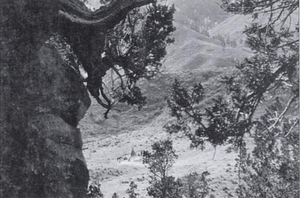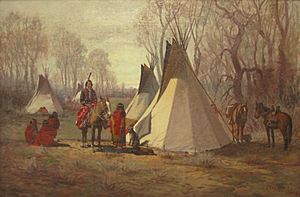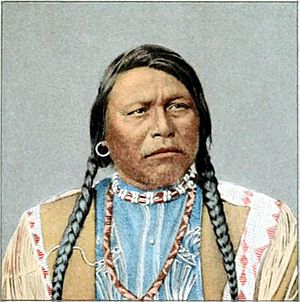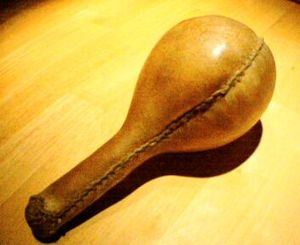Uncompahgre Ute facts for kids
The Uncompahgre Ute are a group of the Ute people. The Ute are a Native American tribe. They live in the US states of Colorado and Utah. In the Ute language, Uncompahgre means "rocks that make water red." This group was once called the Tabeguache.
The Tabeguache Ute: People of Sun Mountain
The Tabeguache (pronounced Tavi'wachi Núuchi) means "People of Sun Mountain" in the Ute language. They were the largest of the ten Ute groups. They were part of the Northern Ute People.
They lived in the river valleys of the Gunnison River and Uncompahgre River. They traveled with the seasons. Like other Ute people, they were hunters. They followed and hunted buffalo, deer, and elk. They moved their camps about once a month. At each new camp, they built a special medicine wheel. This connected them to Mother Earth.
The Tabeguache Ute believed the Pikes Peak region was their home. Their name for the mountain is Tavakiev, which means "sun mountain." They lived a nomadic life, meaning they moved often to hunt and gather food. In summer, they stayed in the Pikes Peak area mountains. Other tribes knew this area belonged to the Ute.
Pikes Peak was a sacred place for the Tabeguache Ute. It had their Sundance grounds. They also used special Ponderosa Pine trees for prayers and other purposes. Some of these trees are 800 years old!

In the fall, they would travel through Ute Pass. They visited special mineral springs. They made offerings to the spirits of the springs for good health and good hunting. There were about ten mineral springs. They called them manitou, meaning "breath of the Great Spirit Manitou." They believed this spirit made the bubbles in the water.
These springs were sacred. Native Americans drank and soaked in the water to heal themselves. Ute and other tribes came to this area. They spent winters there. They shared the gifts of the waters without fighting. Tools found nearby suggest groups gathered to prepare animal hides and meat after hunts.
The old Ute Pass Trail went west from Monument Creek to Garden of the Gods and Manitou Springs. From Ute Pass, Utes traveled east to hunt buffalo. They spent winters in mountain valleys. These valleys protected them from bad weather. The North and Middle Parks of Colorado were favorite hunting spots. They had many animals.
The explorer John Wesley Powell lived with the Northern Ute People in 1868–69. He noticed how important land was to them. He said that an Indian's name for their land was like their "title deed" to their home. Their pride, peace, home, and family life were all connected to their land.
Glowing Rocks: How the Ute Used Quartz
The Uncompahgre Ute Indians from Central Colorado were one of the first groups known to use glowing rocks. They used quartz crystals to make light. This is called mechanoluminescence. It means making light from mechanical stress. You can see flashes of light when quartz crystals are squeezed in the dark. This is also known as Triboluminescence.
Notable People
- Chipeta, Ouray's wife, a Tabeguache Ute
- Ouray (Ute leader), a Tabeguache Ute




